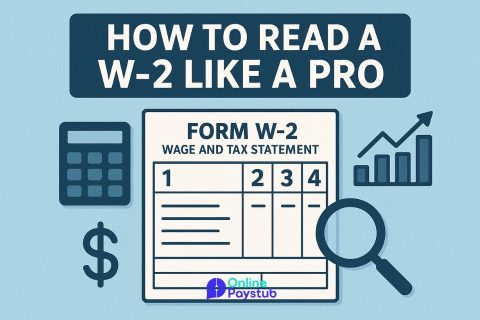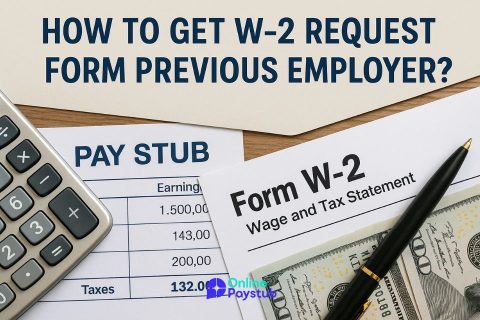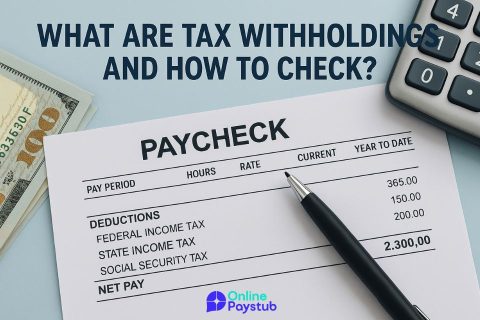Receiving a corrected W-2, formally known as Form W-2c, after you’ve already filed your tax return is more than just a clerical inconvenience. It has the potential to affect your federal and state income calculations, refund eligibility, and even your compliance status with the IRS.
The IRS considers the information reported on your W-2 as a primary data source when processing your return. If the original W-2 was incorrect whether due to misreported wages, withholding errors, or incorrect Social Security earnings your return may no longer reflect your actual tax liability. Failing to address these discrepancies could result in underpayment penalties, refund adjustments, or audit triggers.
Corrected W-2s typically indicate that the employer identified an error after issuing the original document. These corrections can be minor, such as adjusting a rounding mistake, or significant, such as updating previously omitted income or misclassified benefits. Regardless of the nature of the change, taxpayers are responsible for ensuring that their filings remain accurate.
Moreover, the corrected form doesn’t automatically replace the original in IRS records. It requires the taxpayer to take action either by evaluating the impact or proceeding with an amended return. Understanding why this form matters is the first step in mitigating post-filing tax risks and avoiding delayed processing, penalties, or interest accrual.
Common Scenarios That Lead to a Corrected W-2 (W-2c)
A corrected W-2, or Form W-2c, is typically issued when an employer identifies errors on an employee’s originally filed W-2. These corrections are not uncommon and can arise from administrative oversights, system mismatches, or retroactive payroll adjustments. Understanding the reasons behind these corrections helps taxpayers anticipate whether their return might be affected.
One frequent cause is a discrepancy in reported wages. This might occur when year-end bonuses or commissions are misreported or excluded. Similarly, adjustments to pre-tax deductions—such as for retirement contributions or health benefits can result in understated or overstated taxable income.
Incorrect Social Security wages are another common issue. If earnings were reported under the wrong Social Security number or if certain payments were mistakenly excluded from taxable wages, employers are required to issue a W-2c to reflect accurate totals.
Misclassified income, such as confusion between employee wages and contractor payments, can also lead to a correction. In some cases, changes to withholding amounts whether federal, state, or local necessitate an update when the original figures were miscalculated or improperly allocated.
Administrative errors like incorrect names, addresses, or tax year references may seem trivial but still warrant a corrected W-2, especially if they interfere with IRS processing or Social Security earnings records.
While these issues vary in scale, any modification to key tax attributes such as wages or withholding should prompt a careful reassessment of the filed return to ensure compliance and avoid downstream complications.
How a Corrected W-2 Impacts Your Filed Tax Return
A corrected W-2 can directly affect the accuracy and validity of your previously submitted return. Whether the correction relates to income, withholdings, or benefits, even small changes may alter your overall tax liability.
If the updated form shows higher wages or lower withholdings than initially reported, you may owe additional tax. On the other hand, if it reveals overreported income or excessive withholdings, a larger refund or reduced liability might result. Either outcome requires action. Ignoring these differences can trigger notices from the IRS or delay future refunds.
Refund recalculations are not automatic. Once the IRS receives a corrected W-2, it doesn’t amend your return without your involvement. You’re responsible for reviewing the differences, assessing the financial impact, and deciding whether to file an amended return.
The IRS uses employer-submitted data to verify filings. If what you submitted doesn’t match what your employer later corrects, the discrepancy may flag your return for review. This kind of mismatch, especially if left unaddressed, increases the likelihood of audits or processing delays.
State tax filings are also affected. Many state agencies use the same wage data reported on the W-2. A correction to federal figures may require updates at the state level as well, especially in jurisdictions where income taxes or tax credits depend on wage reporting.
Timely response to corrected information helps avoid penalties, interest, and enforcement actions. It ensures your filings remain compliant and accurately reflect your earnings and obligations.
IRS Requirements: When Are You Obligated to File an Amended Return?
The IRS expects taxpayers to file an amended return when a corrected W-2 reveals information that would change the outcome of the original filing. This includes adjustments that affect total income, tax owed, or refund eligibility.
If the corrected W-2 increases your taxable income or reduces withholdings, you’re expected to act. Delaying or avoiding the amendment can lead to penalties or interest if the IRS later identifies underpayment. On the flip side, if the correction lowers your income or increases tax paid, you’re entitled to claim the difference but only if you submit an amended return.
The agency does not require amended returns for minor changes that have no effect on tax liability. However, what qualifies as “minor” isn’t formally defined, which leaves room for interpretation. As a result, it’s often safer to assess any difference carefully rather than rely on assumptions.
The IRS does not automatically make corrections on your behalf. Even if your employer submits the W-2c directly to the IRS, the obligation to reconcile your return remains with you. The IRS may eventually contact you about mismatches, but that process can take months and may include interest on unpaid taxes.
Deadlines matter. You generally have three years from the date you filed your original return or two years from the date you paid the tax, whichever is later to submit Form 1040-X. This window defines your eligibility to claim a refund or adjust liability.
Form 1040-X Explained: Amending Your Tax Return Step-by-Step
Form 1040-X is the official document used to correct errors on a previously filed federal tax return. If a corrected W-2 affects the figures you originally submitted, this form serves as the mechanism for making those changes in a formal, traceable way.
The form includes three columns: the original amounts reported, the corrected values, and the difference between the two. It requires an explanation of the reason for the amendment, typically a brief statement referencing the corrected W-2 received after filing.
Begin by reviewing the corrected W-2 and comparing it line by line with the version used in your original return. Focus on income, withholding, and any adjustments that affect tax credits or deductions. If state taxes are also impacted, prepare a separate amendment for the relevant state agency, as Form 1040-X does not update state filings automatically.
Form 1040-X must be mailed for most corrections, though recent updates allow some electronically filed returns to be amended online through IRS systems or tax software. Not all taxpayers qualify for e-filing the amendment, so verify eligibility before proceeding.
Supporting documents are essential. Attach a copy of the W-2c and any schedules affected by the changes. If the corrected information alters eligibility for credits like the Earned Income Tax Credit or Child Tax Credit, include recalculated worksheets.
Keep in mind that processing times for amended returns are significantly longer than original filings. The IRS advises allowing up to 20 weeks. During this period, it’s common not to receive updates through regular refund tracking tools.
A precise, well-documented 1040-X filing ensures that your tax history is accurate and compliant. It also prevents interest accumulation and establishes a clear record in case of future questions or audits.
Will You Owe More or Receive Less?
When a corrected W-2 changes key figures like wages or withholdings, the impact on your refund can be immediate and material. Depending on the nature of the correction, you may either owe additional tax or be eligible for a larger or smaller refund than originally anticipated.
If the W-2c reflects increased income without a corresponding rise in withheld taxes, the balance owed can rise. This is particularly common when bonuses, commissions, or taxable fringe benefits were previously omitted. In such cases, failure to amend your return may lead to notices from the IRS for underpayment, plus interest.
Conversely, if the correction reduces your taxable income or shows additional withholdings, you may become entitled to a higher refund. However, this money isn’t automatically paid unless you take steps to amend your return using Form 1040-X.
Timing is another factor. If your return was already processed and a refund issued before you received the corrected W-2, any recalculation will be treated as a separate case. You won’t be required to return funds already received unless you amend and it results in a balance due. But ignoring the correction altogether, especially when it increases tax liability, can raise audit risk.
Refund recalculations may also affect eligibility for income-based credits. A change in reported income can move you into or out of thresholds for certain tax benefits. For example, the Earned Income Tax Credit has strict income limits. A small upward revision can eliminate eligibility, while a downward correction could make you newly qualified.
What If You Already Received a Refund Before Receiving the W-2c?
Receiving a corrected W-2 after your refund has already been processed creates a specific type of tax dilemma. The IRS doesn’t reclaim a refund automatically, even if new information surfaces post-filing. Responsibility falls on you to review the changes and determine whether an amended return is required.
If the W-2c increases your reported income or reduces withholdings, there’s a chance that your original refund was too high. In that case, filing an amended return is not just a formality—it may prevent future IRS actions. Interest and penalties can accrue if the agency later determines the original return underreported liability.
On the other hand, if the correction favors you—such as showing more withheld tax or less income—you can claim the additional amount by amending your return. Ignoring the opportunity means forfeiting funds legally owed to you.
The situation becomes more complex when credits are involved. A refund based on income-dependent credits like the Earned Income Tax Credit or the Premium Tax Credit may need recalculation. A corrected W-2 could disqualify or newly qualify you for these programs, impacting not only your federal return but potentially your state filing as well.
It’s important to act within the amendment window. IRS rules allow three years from the original filing date or two years from when you paid the tax, whichever is later. Beyond that, amendments for refund purposes are no longer accepted.




No comments to show.